A Nose in Your Clothes

A U.K. company says its highly pressure-sensitive material could be used to integrate an “electronic nose” into paper or clothing.
Peratech’s sensor rapidly detects volatile organic compounds (VOCs)—gases in our surrounding environment that are produced by a wide variety of sources, everything from household paints to a person’s own skin. Many do not have an odor, but an electronic sensor could alert a user to the presence of harmful chemicals or perhaps indicate that something is off-kilter with a user’s health. Peratech’s approach follows a long history of attempts to build portable and sensitive electronic noses, but the company claims its technology makes for a faster sniffer that produces a much larger response signal (change in electric charge). Furthermore, its sensors can be a few microns thick, broadening potential applications.
“By using a new sensing medium, we are taking it out to areas where previously it wasn’t viable,” says David Lussey, Peratech’s chief technology officer. For instance, the VOC sensors could be integrated into protective clothing for first responders entering chemically contaminated areas, or into everyday clothing to monitor a person’s own VOCs, which could indicate health status.
Peratech builds its sensors with its quantum tunneling composites (QTCs), which have previously been used to create pressure-sensitive touch screens. In quantum tunneling, electrons jump between conductors that are distributed through an otherwise nonconductive matrix. Deformation like twisting or bending brings the conductors close enough to one another that electrons can travel this way. In the case of the new sensors, the QTC is made of VOC-absorbing polymers that are spotted with Peratech’s conductive metallic particles. When the polymer absorbs a VOC, it swells, thus pushing the conductive particles closer to one another, enabling quantum tunneling and thus electron flow.
Building VOC sensors with absorptive polymers and conductive materials is a well-known approach, says Tim Swager, MIT professor of chemistry and chemosensor expert. Historically, the method has not been very sensitive. One of the few real-world applications has been for product validation, such as monitoring food production for batch-to-batch consistency. In industrial settings, there are large amounts of a compound for the sensor to sniff out. Similar technologies “never worked for trace sensing,” says Swager, referring to tiny but significant quantities of a target compound.
What’s more, the polymers used may not be completely specific to a particular VOC, which could be problematic if the sensors are used in an uncontrolled environment full of diverse compounds. Whether Peratech will be able to solve these polymer problems remains to be seen—the company is looking for collaborators that are interested in exploring polymer selectivity and sensitivity in its sensors.
A special feature of Peratech’s sensor is that it can be printed in thin film. Many of the electronic noses available today are handheld walkie-talkie-like devices. Peratech’s sensor requires a low amount of power that could be supplied by a small dedicated power source integrated into clothing. Alternatively, power could come from a mobile phone in a wearer’s pocket attached to the sensor via washable ribbon cables.
Lussey expects many more uses to come from Peratech’s QTCs. The company’s website suggests dozens of uses: from portable fabric keyboards to prosthetics with pressure-sensitive skin to more secure RFID cards. “What we have here is a small tiger by the tail. There are so many things we can do with this stuff, but we are doing one thing at a time.”
Keep Reading
Most Popular
Large language models can do jaw-dropping things. But nobody knows exactly why.
And that's a problem. Figuring it out is one of the biggest scientific puzzles of our time and a crucial step towards controlling more powerful future models.
The problem with plug-in hybrids? Their drivers.
Plug-in hybrids are often sold as a transition to EVs, but new data from Europe shows we’re still underestimating the emissions they produce.
How scientists traced a mysterious covid case back to six toilets
When wastewater surveillance turns into a hunt for a single infected individual, the ethics get tricky.
Google DeepMind’s new generative model makes Super Mario–like games from scratch
Genie learns how to control games by watching hours and hours of video. It could help train next-gen robots too.
Stay connected
Get the latest updates from
MIT Technology Review
Discover special offers, top stories, upcoming events, and more.